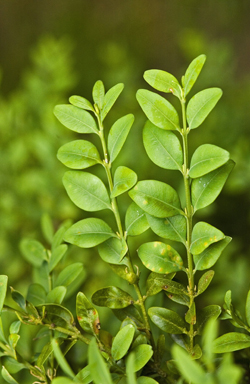|
Common box belongs to the genus Buxus and is a member of the Box family (Buxaceae).
Common box (Buxus sempervirens) is an evergreen tree growing to 6m and flowering April to May.
Lifespan: Box can live for many hundreds of years.
Characteristics
Bark is smooth and grey, becoming fissured with age. Growth is compact, dense and spreading with green, angled, downy stems. Leaves are opposite on short stalks, oval with blunt tips 10–25mm long, shiny, leathery and dark green.
Common box is monoecious: both male and female flowers are found on the same tree. Flowers are green and grow in clusters in the leaf axils. Each cluster contains several male flowers with conspicuous whitish-yellow anthers and a terminal female flower containing a three-celled ovary.
Female flowers develop into a green, dry capsule and ripen to a brown, woody case which splits into three segments; each segment releasing two black seeds. Box is wind pollinated.
|












